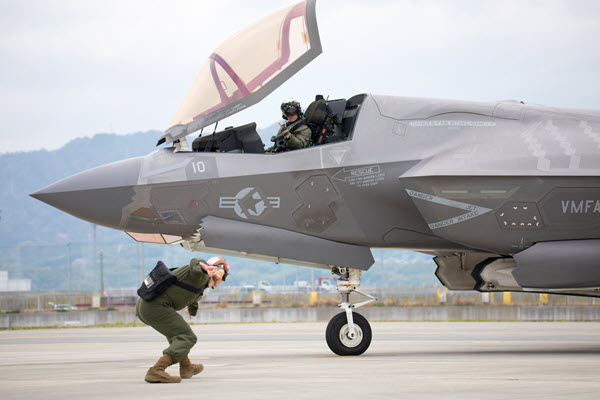
Iwakuni, Japan. (April 7, 2023): In this photo by Corporal Tyler Harmon, fixed wing aircraft mechanic Lance Corporal Herbert Tunley III signals to pilot Major Douglas Kansier, F-35B Lightning pilot and executive director of Marine Fighter Attack Squadron 242 during flight operations in the Indo-Pacific. This remarkable aircraft is the backbone of American combat aviation and will represent the bulk of the crewed tactical aircraft of the U.S. Air Force, Navy, and Marine Corps for several decades to come.
The Lockheed Martin F-35 Lightning II is a single-seat, single-engine, all-weather stealth multirole combat aircraft that is intended to perform both air superiority and strike missions. It is also able to provide electronic warfare and intelligence, surveillance, and reconnaissance capabilities as needed.
The aircraft comes in three versions, the conventional takeoff and landing F-35A, the short take-off and vertical-landing F-35B, and the carrier-based F-35C.
The Marine variant pictured above is a short take-off and vertical landing jet able to take off from a short runway (or take off vertically if it does not have a heavy payload) and land vertically (i.e. with no runway). Incredibly, the F35-B can clear a 50-foot obstacle and needs only 1,500-foot runway to takeoff. Designed to operate from remote expeditionary airfields or within range of air-capable ships, the F-35B features a vertical lift fan and pivoting engine nozzle to deliver vertical landing virtually anywhere a landing strip can be constructed.
The Lightning II entered service with the U.S. Marine Corps in July 2015 and the U.S. plans to buy an additional 2,456 F-35s through 2044. The origins of the F35 can be traced to the highly secretive Defense Advanced Research Projects Agency (DARPA) that developed stealth technology that conceals the F35 from enemy radar. The F35 can safely penetrate enemy airspace using its stealth features and radar evading technology to attack targets at long ranges without detection.
Naturally, this aircraft is fast (up to 1,200 mph), is long range (up to 900 miles) and can launch two AIM air-to-air missiles, two one-thousand pound GBU bombs, and the highly destructive JDAM guided munitions.
This extraordinary aircraft is planned to be the cornerstone of NATO and U.S.-allied air power until 2070.


